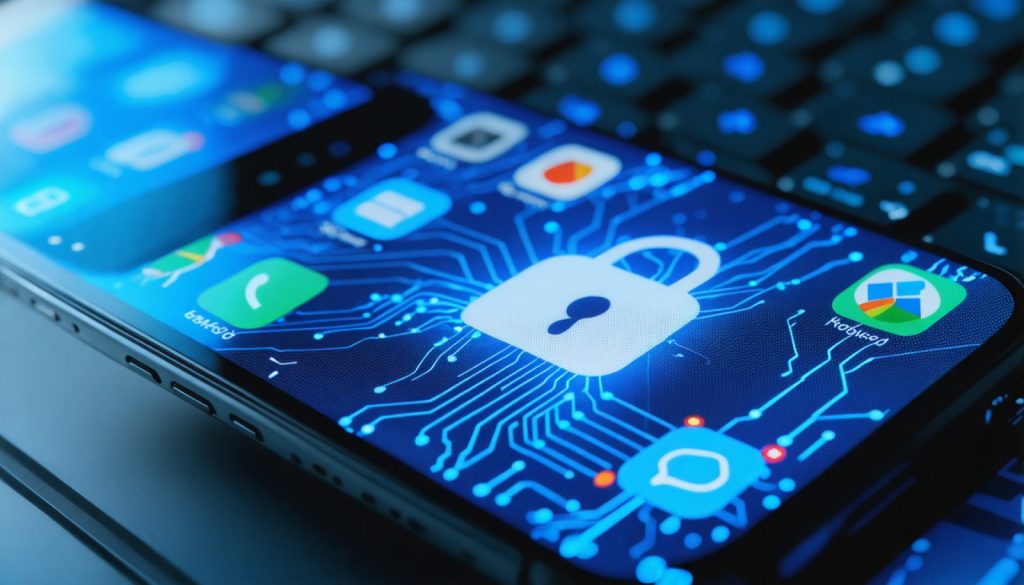
- Mobile apps store vast amounts of private data, becoming prime targets for cybercriminals.
- Approximately 82.78% of iOS apps track user data, raising concerns over privacy and security.
- API calls and background syncing in apps provide opportunities for cyber intrusions.
- Broad app permissions increase vulnerability, as users grant extensive access unknowingly.
- AI technologies enhance threats, bypassing multi-factor authentication with precision.
- Mobile apps contain identifiers like install IDs and analytics data, offering entry points to hackers.
- Security defenses focus on server-side protection, leaving mobile app frontlines exposed.
- Integrating in-app protections against tampering and reverse engineering strengthens security.
- An evolved approach involves developers, security professionals, and users in bolstering app defenses.
Mobile apps are the silent gatekeepers of our personal lives, holding a reservoir of private data that is growing ever more tempting for cybercriminals. Unsuspectingly, users hold a small universe in hand — one that contains everything from personal messages to financial information. Amid this interconnected web, an alarming 82.78% of apps in the iOS ecosystem alone are designed to track user data, raising the stakes for privacy and security.
Imagine a bustling cityscape of ones and zeros, with unseen pathways where nefarious actors lurk. Disguised entrances and exits in mobile apps — like API calls and background syncing — present ripe opportunities for cyber intrusions. Here, traditional security measures often lag, only recognizing breaches once repercussions begin to surface.
Complacent app permissions further exacerbate the threat. Users unwittingly granting broad access make mobile environments the preferred playground for hackers. The introduction of AI technologies has flipped the script of how these intrusions unfold; it turns into a powerful ally for hackers, capable of bypassing multi-factor authentication and exploiting vulnerabilities with unprecedented precision and speed.
The landscape of cyber defense is undergoing a transformation, but for the everyday user, the ramifications of AI-enhanced threats paint a daunting picture. As AI learns to replicate human cunning but at an amplified scale, the imperative for using these tools for protective measures has never been more critical.
Why does your mobile app seem like a goldmine to hackers? Beyond their omnipresence and convenience, mobile apps harbor a myriad of soft identifiers: install IDs, ad metadata, and analytics data that tell a tale about users without resistance. This data “exhaust” effortlessly flows at scale, quietly alerting threat actors to a plethora of exploitable entry points. Mobile apps were never intended to prioritize security; they were tailored for attribution and efficiency, creating a gaping void in protection.
The chase for security solutions traditionally focuses on fortifying backends. While these walls shield data servers holding multitudes of user information, they leave mobile app frontlines exposed. With this imbalance, attackers pivot intuitively, exploiting weak defenses in mobile app logic and runtime operations.
Defensive strides lie not only in beefing up server-side security but in integrating in-app protections too. By hardening app environments against tampering, reverse engineering, and runtime manipulation, the industry edges closer to stemming this tide of digital vulnerability.
In a world teeming with digital conveniences, the call to action involves increasing awareness and evolving strategies. Each click and each app interaction carry the dual burden of user benefit and potential threat. The onus lies on developers, security professionals, and users alike — to tighten the threads of security around the digital pot of gold resting in our pockets, ensuring that technology serves us with the fidelity it promises, rather than the threat it could unleash.
How to Protect Your Mobile Apps from Prying Eyes: Top Security Tips Revealed
Mobile applications have woven themselves deep into the fabric of our daily lives, holding a vast trove of personal information that is increasingly attractive to cybercriminals. For hackers, mobile apps represent a goldmine, allowing them to access everything from personal communications to sensitive financial details. The stakes for privacy and security are high, with reports indicating that a staggering 82.78% of iOS apps are built to track user data.
Why Are Mobile Apps Attractive to Hackers?
Mobile apps are rife with “soft identifiers” such as install IDs, ad metadata, and analytics data. This information paints a detailed picture of the user, providing hackers with ample opportunities to exploit. However, the very architecture of these apps was not designed with security in mind, focusing instead on efficiency and user experience. This creates significant vulnerabilities for attackers to exploit.
How-To Steps: Secure Your Mobile App Use
1. Review App Permissions: Regularly check and limit the permissions you grant to apps. Avoid giving unnecessary access to your location, contacts, or camera.
2. Keep Apps and Devices Updated: Ensure your operating system and all apps are updated to leverage the latest security patches.
3. Use Strong, Unique Passwords: Implement a strong password policy for all your app accounts. Consider using a password manager to maintain unique credentials.
4. Enable Two-Factor Authentication (2FA): Whenever available, enable 2FA to add an additional layer of security.
5. Install Security Software: Utilize comprehensive mobile security solutions to monitor for malicious activities and reinforce defenses.
Industry Trends: The Rise of AI in Mobile Security
While AI has been leveraged by hackers to amplify attacks, it is also an emerging pillar in cybersecurity practices. AI-driven security systems can predict threats, identify new attack patterns, and react in real-time to thwart potential breaches. This highlights the importance of adopting AI solutions to proactively defend against complex cyber threats.
Pressing Questions Readers Often Have
– How Do Hackers Exploit Mobile Apps?
Hackers exploit apps through a variety of methods, including phishing schemes, malware, and direct exploits of app vulnerabilities.
– Are iOS Apps Safer Than Android Apps?
While Apple’s ecosystem is closed, offering somewhat reduced risk, neither platform is entirely safe. Security largely depends on the user’s practices and app permissions.
Pros and Cons Overview
Pros of Mobile App Convenience:
– Instant Access: Access to services with a tap.
– Personalized Experiences: Apps tailor services to users’ preferences.
Cons of Potential Risks:
– Privacy Erosion: Extensive tracking can leak personal information.
– Security Risks: Increased chances of exploitation due to inherent vulnerabilities.
Actionable Recommendations
– Regularly Audit Your Apps: Delete apps you no longer use to minimize your exposure to tracking and attacks.
– Educate Yourself and Others: Understanding digital threats empowers you to make informed security decisions.
By adopting these strategies and remaining vigilant, users can safeguard their mobile applications and the data within them. With ongoing advancements in AI and mobile security, staying informed and proactive is critical.
For further information on improving digital security, visit Kaspersky or Norton.



